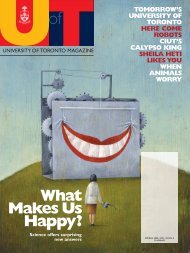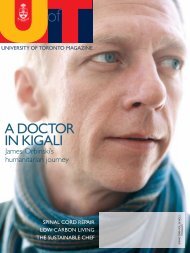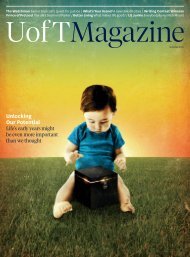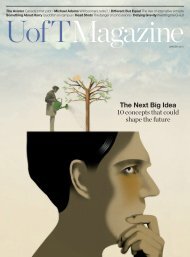What's the solution to Toronto's traffic problems? - University of ...
What's the solution to Toronto's traffic problems? - University of ...
What's the solution to Toronto's traffic problems? - University of ...
Create successful ePaper yourself
Turn your PDF publications into a flip-book with our unique Google optimized e-Paper software.
Life on Campus<br />
Mengqi Wang (left)<br />
and Rozita Abdoli<br />
Engineering a Cure<br />
Undergraduate students design <strong>the</strong>ir<br />
own experiments <strong>to</strong> address important<br />
medical questions<br />
NOT MANY UNDERGRADUATES can say <strong>the</strong>y’ve worked on finding<br />
a cure for cancer. But that’s exactly what two upper-year<br />
students at <strong>the</strong> Institute <strong>of</strong> Biomaterials and Biomedical<br />
Engineering did recently as part <strong>of</strong> an experiment <strong>the</strong>y<br />
designed and executed <strong>the</strong>mselves.<br />
The project, by Rozita Abdoli, a chemical engineering<br />
major, and Mengqi Wang, a specialist in electrical and<br />
computer engineering, examined<br />
“HeLa” or cervical cancer cells<br />
under stress. Their goal To find<br />
new ways <strong>to</strong> tackle <strong>the</strong> disease at<br />
<strong>the</strong> cellular level. In <strong>the</strong> end, <strong>the</strong><br />
study didn’t reveal as much as <strong>the</strong><br />
students had initially hoped, but it<br />
provided <strong>the</strong>m with a better understanding<br />
<strong>of</strong> <strong>the</strong> HeLa cell line,<br />
Wang observes.<br />
The study was one <strong>of</strong> several that<br />
third- and fourth-year undergrads<br />
at <strong>the</strong> institute shared recently with<br />
<strong>the</strong> public.<br />
Biomedical engineering majors<br />
Tara Strat<strong>to</strong>n and Andrea Pagot<strong>to</strong><br />
looked at ways <strong>to</strong> amplify and tag<br />
DNA sequences <strong>of</strong> E. coli bacteria<br />
<strong>to</strong> find an easier way for scientists<br />
<strong>to</strong> test for <strong>the</strong> deadly organism<br />
in freshwater samples. The methods used showed promise,<br />
<strong>the</strong>y say.<br />
Richard Gao and Om Bhatt, engineering science specialists,<br />
studied <strong>the</strong> adverse effects <strong>of</strong> electrical fields on two<br />
different stem cell lines. Their study found that many stem<br />
cells die when exposed <strong>to</strong> an amplified electrical field.<br />
Unlike courses where <strong>the</strong> right answer is <strong>the</strong> only answer,<br />
courses that include major design projects allow students<br />
<strong>to</strong> learn through trial and error – like real scientists do.<br />
“Theory is best learned when our students have <strong>the</strong> opportunity<br />
<strong>to</strong> apply <strong>the</strong>ir classroom knowledge <strong>to</strong> real-world<br />
engineering challenges that have <strong>the</strong> potential <strong>to</strong> make an<br />
impact,” says Pr<strong>of</strong>. Paul Santerre, <strong>the</strong> institute’s direc<strong>to</strong>r.<br />
“That’s what our students have aspired <strong>to</strong> in this course.”<br />
– ERIN VOLLICK<br />
Help us reduce waste!<br />
Are you <strong>the</strong> intended recipient <strong>of</strong> this copy <strong>of</strong> U <strong>of</strong> T Magazine<br />
If not, please have <strong>the</strong> name removed from our mailing list by calling<br />
1-800-463-6048 or by sending an email message <strong>to</strong><br />
address.update@u<strong>to</strong>ron<strong>to</strong>.ca<br />
PHOTO: ERIN VOLLICK<br />
summer 2012 17

















